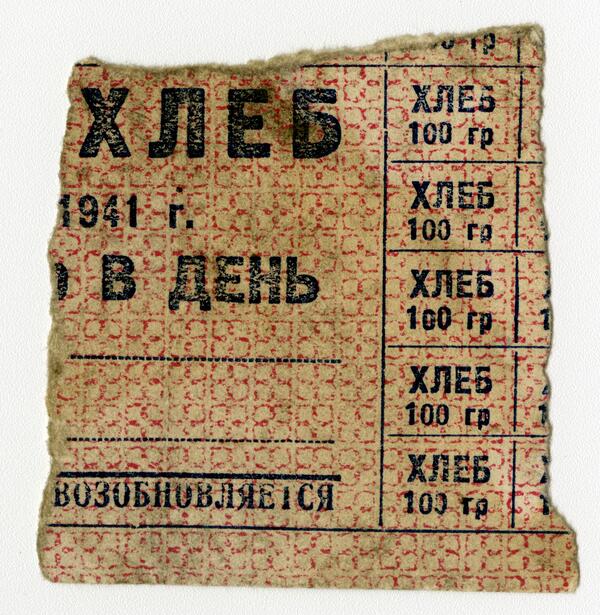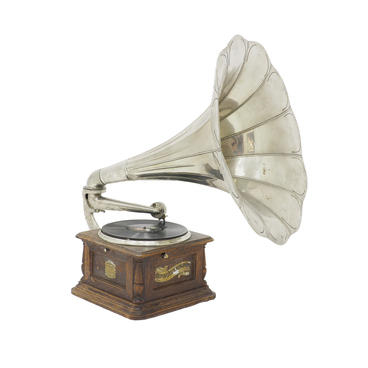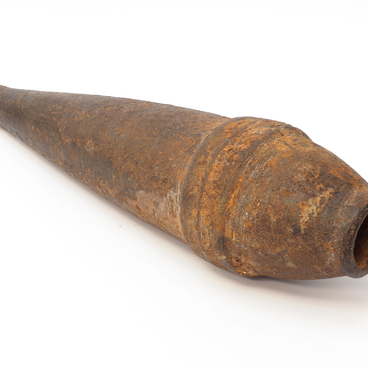The history teacher Raisa Terekhova gave this piece of bread to the museum in 1995. She got this daily ration of bread in 1974–1975 in Arzamas-16 (a closed town in Nizhny Novgorod Oblast, Russia) from her student whose parents were scientists, and, supposedly, lived in Leningrad during the siege.
The bread was extremely valuable during the siege, as the whole city suffered a lack of food. The citizens were given daily rations of bread. The only route of communication with Leningrad—across Lake Ladoga—was under the fire of the enemy artillery and Air force. The enemy’s navy was right on the lake. Under such conditions, the amount of food supply transported to the city could not possibly meet the needs of all the citizens. In addition, when winter came, famine in the Leningrad region became even more extreme: thousands of people died of cold because of problems with the heating.
In the first few months of the Great Patriotic War, workers received 800 grams of bread, but later on, the daily bread ration was reduced to 600 grams. And after the beginning of the siege of Leningrad on September 8, 1941, the daily food ration was 500 grams: almost all supply routes to the city were cut off by German forces, and there was less and less bread for the people.
This daily bread ration reached its minimum in late autumn of 1941 when it was the third month of the siege: from November 20, children and dependents received only 125 grams of bread. The rules got stricter for other citizens as well: workers and soldiers were getting 250 grams of bread per day.
Siege bread was a thin piece of bread that had a brown color and contained inedible admixtures. It consisted of rye, oat, soy, and malted barley flour, linseed cake, and bran. When the food supply of the city was depleted, cottonseed oilcake, edible cellulose, and wallpaper dust began to be added to the list of ingredients.
The bread was distributed in accordance with ration cards (coupons/stamps), and civilians would wait in huge lines for many hours to receive them. Many would collapse from hunger while waiting. If the card was lost or stolen, the person was facing the risk of dying of starvation. People were ready to exchange any valuable items or clothes for a slice of bread, and mothers would often give their piece of bread to their starving children.
Soviet forces managed to open a narrow land corridor to the city only on January 18, 1943, and from mid-February, the food supply in Leningrad was resumed. However, the city was still exposed to the enemy’s fire, and the Red Army did not lift the siege until January 27, 1944. In 1965, Leningrad was awarded the title ‘Hero City’ for the exceptional heroism and bravery of its citizens.
The bread was extremely valuable during the siege, as the whole city suffered a lack of food. The citizens were given daily rations of bread. The only route of communication with Leningrad—across Lake Ladoga—was under the fire of the enemy artillery and Air force. The enemy’s navy was right on the lake. Under such conditions, the amount of food supply transported to the city could not possibly meet the needs of all the citizens. In addition, when winter came, famine in the Leningrad region became even more extreme: thousands of people died of cold because of problems with the heating.
In the first few months of the Great Patriotic War, workers received 800 grams of bread, but later on, the daily bread ration was reduced to 600 grams. And after the beginning of the siege of Leningrad on September 8, 1941, the daily food ration was 500 grams: almost all supply routes to the city were cut off by German forces, and there was less and less bread for the people.
This daily bread ration reached its minimum in late autumn of 1941 when it was the third month of the siege: from November 20, children and dependents received only 125 grams of bread. The rules got stricter for other citizens as well: workers and soldiers were getting 250 grams of bread per day.
Siege bread was a thin piece of bread that had a brown color and contained inedible admixtures. It consisted of rye, oat, soy, and malted barley flour, linseed cake, and bran. When the food supply of the city was depleted, cottonseed oilcake, edible cellulose, and wallpaper dust began to be added to the list of ingredients.
The bread was distributed in accordance with ration cards (coupons/stamps), and civilians would wait in huge lines for many hours to receive them. Many would collapse from hunger while waiting. If the card was lost or stolen, the person was facing the risk of dying of starvation. People were ready to exchange any valuable items or clothes for a slice of bread, and mothers would often give their piece of bread to their starving children.
Soviet forces managed to open a narrow land corridor to the city only on January 18, 1943, and from mid-February, the food supply in Leningrad was resumed. However, the city was still exposed to the enemy’s fire, and the Red Army did not lift the siege until January 27, 1944. In 1965, Leningrad was awarded the title ‘Hero City’ for the exceptional heroism and bravery of its citizens.


